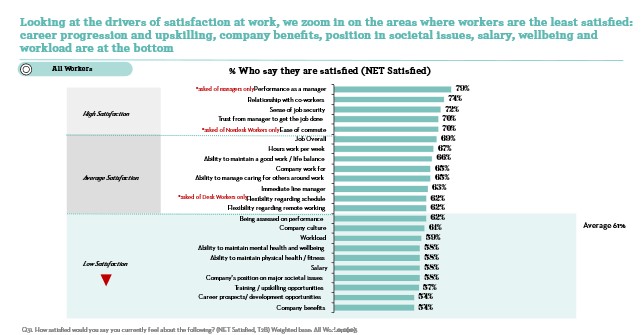Download our report, Global Workforce of the Future, here.
We are experiencing the highest inflation levels in decades. In Europe, energy and food supplies were disrupted earlier this year as a result of Russia's invasion of Ukraine. Inevitably, higher energy costs result in higher prices.
In our report, Global Workforce of the Future, most workers leaving their jobs in the next 12 months cite salary as their top reason. But that’s not the full story. What factors play a role in when – and why – workers leave their jobs?
Wage Inflation
Because of higher inflation, businesses face a greater challenge in recruiting talent as they approach contract negotiations with higher salary expectations. The increase in nominal wages is known as wage inflation. A rise in wages tends to lead to a rise in prices and a rise in growth. Whether a wage increase is a real one (higher than inflation) or a nominal one (precisely the same as inflation) determines the impact of wage inflation.
With employers grappling with wage inflation, this article focuses on areas other than salary that workers consider highly important, but where they are least satisfied at the moment. These are levers that the organization can use to address talent retention and attraction.
Can a higher salary solve the talent shortage problem?
Workers cite salary as the number one reason for leaving their company in the coming months. In our study, however, we found that after workers become engaged (those who claim to wish to stay with their current company for the next year), salary becomes secondary and falls to 6th place on the list of reasons for staying.
In other words, although salary is the top consideration for changing companies, if employees are engaged, salary isn't the top consideration for those who remain in the same company long-term. The buzz of a new, higher salary wears off. So, to achieve employee engagement, companies need to redefine what it means to work for them.
These are the retention levers where companies can make a difference in retaining talent. Salary is one, but career progression, flexibility (e.g. 4-day work week), and mental well-being are also important.
A company's ability to retain talent depends on the following areas, which we refer to as retention levers:
- Salary
- Flexibility
- Career Progression
- Mental Health
What makes workers quit?
After salary, work/life balance, trying something new, being unhappy at their current job, and lack of career advancement are the top five reasons for leaving a job. There is a significant difference in the number of non-managers (52%) who choose a higher salary as compared to managers (37%).

What makes workers want to stay?

Drivers of satisfaction at work
Our study examined the factors driving employee satisfaction at work in order to pinpoint the areas in which workers are less satisfied.
69% of employees are satisfied with their job overall, compared to 67% in 2021. China, Brazil, and Turkey have the highest satisfaction rates among workers, while Japan and some European countries (France, Greece, and Italy) have the lowest.
Key Takeaways
It is reported that workers are least satisfied with the workload, ability to maintain mental and physical health and wellbeing, salary, career advancement and upskilling. To maintain mental health and wellbeing, non-desk workers are significantly less satisfied than desk workers are. A 52%versus a 65%difference.

Therefore, all workers need more than money to define a successful working life. Having a good work-life balance, feeling satisfied at work, having job security, and loving their work come before money for workers. Focus is placed on those areas that have been identified by workers as highly important and are drivers of low work satisfaction. And once more, there is a significant difference between non-desk workers and desk workers when it comes to their ability to maintain their mental health and wellbeing. There was a 52% vs. 65% difference.
Key Takeaways
It is crucial for organisations to prioritise their retention efforts by identifying factors that have a high importance and low satisfaction level among their workers. Salary is still a key driver for employee attraction and retention although managers are more likely to report higher salaries compared to non-managers (6 in 10 reporting higher salaries). In addition, only 4 out of 10 non-managers believe that their pay reflects their performance. This results in companies losing their talent pipeline by focusing on managers’ salaries only.
The key to understanding salary benchmarks and accessing top talent pools is to partner with experts. As part of our permanent recruitment solutions, Adecco can help you hire the best talent at the right price.



